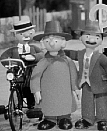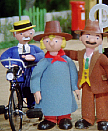 | ||||
Camberwick Green, Trumpton and Chigley
Camberwick 1st hit the screens at 1.30pm on January 3rd,1966 ....
And 1966 was a time when .... the UK tv landscape was so far removed from what we have today ....
that it's actually quite hard to comprehend.
But there really were just 3 channels. BBC 1 .... BBC 2 .... and .... ITV.
No Satellite .... No Cable .... No Freeview .... Not even Channels 4 and 5.
Everything was still broadcast in black & white ....
And without even VHS there was no means of either recording or buying tv shows.
So you were totally reliant on repeats to see a re-run.
The amount of pre-school viewing available was predictably limited.
Because apart from US cartoons,the UK output was basically just one programme featuring real people - "Play School" - and various "fantasy" series under the famous BBC "Watch With Mother" umbrella that only used string puppetry or hand puppets.
So when Camberwick joined the "Watch With Mother" stable its use of 3D stop motion animation was unique and completely transformational.
Add in the total absence of the Internet and social media on top of the extremly limited tv viewing and there was simply so much more room for kids to be spellbound by something new.
And a Camberwick world brought to life by stop motion provided just that sense of wonder .... even in black and white.
Camberwick was made by stop motion it .... and made for it.
Without it,Camberwick,Trumpton and Chigley wouldn't have been made at all.
And millions of kids would be forever grateful.
Video,below .... Of course,a lot of you will never have seen them in black and white.
So I've specially tweeked the opening titles so they start in b&w,and change to CamberColour part the way through.
And just imagine what it must have been like for any youngster who straddled the changeover from black and white, and saw them in colour for the first time.
Probably slightly surreal,combined with a wonderful bit of sensory overload.
And actually a subject that a whole 1998 movie was based around. Check out "PleasantVille" on YouTube.
The 1st episode featured Peter Hazell,the Postman ....
And over the next 12 episodes a different character emerged from the music box,with each storyline woven around them.
And at such a tender age,the suspense of waiting to see who'd emerge was great. Simple,yes.But very effective.
The Peter Hazell episode is worth singling out because it also doubled as the original pilot episode.
And there were certain time-consuming elements that clearly caused the production team to have a rethink prior to filming the rest of the series ....
# 1 The use of dancing to accompany the songs .... axed !
In that 1st episode,Peter Hazell's little dance with Mrs Dingle in the Post Office proved to be the only dance sequence in all 3 series .... Apart from the biscuit factory dance at the end of every Chigley episode.
Why ? Simply because they were too time-consuming to animate on a one-off basis.Whereas the Chigley scene was different because it was stock footage that was re-used for all 13 episodes,so the extra time could be justified.
# 2 The use of mouth movements .... axed !
Lip-synching was avoided altogether of course because it would have been far too time-consuming and costly.
But,in the 1st episode they did start out using the odd isolated shot of an "open" mouth to reinforce surprise or an exclamation.
ie. Some whistling in Windy's episode .... An "ouch !" when Micky Murphy burns his hand .... etc
In fact,this actually lasted for the first 2 or 3 Camberwick episodes before being finally dropped entirely.
A detailed look at all the Camberwick Locations
Camberwick Green is in the County of Trumptonshire.
A small,country hamlet based around The village green ....
Well,the "Green" is actually just a large tree with a seat round it and a small ( very small ) bit of greenery.
All the houses that are grouped around are detached.Or,link-detached in the case of the Bakery and Fishmongers.
And there's a real mish mash of architectural styles.
From Doc Mopp's Georgian splendour to a Post Office which looks as though it's just dropped in from the Swiss Alps.
Throughout the entire series we're never shown the whole Green in one shot.
Very civilised shopping hours too :- 9 till 5 except half-day early closing at 1pm on Wednesdays & Saturdays.
And closed all day Sundays ie.pretty much what real world shoppers would have experienced in the UK in 1966.
From left to right ie.in the order they appear on screen ....
1. The Murphy Family Bakery 2. Mr.Carraway's Fish Shop (Open in Pic 2 & Closed in 5)
3. Mrs.Dingle's Post Office & General Stores 4. Dr.Mopp's House / Surgery.
5. The 'Green' around which they're located [shown with Carraway's shutter pulled down]
1. 2. 3. 4. 5.
The producers knew it would initially be shown in black & white.
But they also knew that there'd be little or no call for black and white programmes when colour arrived.
So 2 seperate versions were actually filmed in tandem.
One in black & white,and one in colour.
Which isn't quite the no-brainer that you might think.
As it meant extra costs onto an already over-stretched budget.
With no guarantee the series would be successful enough for colour repeats to actually be required.
But a shelf life of over half a century on tv,vhs,dvd and blu-ray proves just what a huge call it was to get right !
Either side of the Bakery and Doc Mopp's house ? Brief stretches of brick wall and open countryside.( see pic 4 )
Missing .... The Chemist's Shop ....
Mrs.Honeyman was the wife of the Chemist,but we never actually saw the shop ( or him for that matter ).
Presumably it's on the other side of the Green ? ie. the side we never see.
Interior shots of the above - This is the full extent of what's shown:-
The Bakery .... 1a. This is the only area shown downstairs. 1b. Paddy & Mary's bedroom. Only shown in one ep.
The FishMongers .... There are no interior shots. We never get past the threshold.
The Post Office .... 2a. The shop & post office counter. And not used nearly as much as you might have thought.
Dr Mopp's House .... 3a. Downstairs room only. Only shown in one episode.
1a 1b 2a 3a
Other Locations outside the Green
Whilst the Green is obviously the central hub,the exact whereabouts of the other locations is difficult to establish.
And we can only live off scraps like Mickey Murphy saying that Colley's Mill is "quite a long way" from his shop.
Or the fact that son Paddy can rollerskate from there to the Dairy.And so on.
Anyhow,here they are in no particular order.And I've tried to select the widest/best views of them we're given.
Pics below .... Top row,from left to right ....
Colley's Mill ( Windy's home/workplace ) In addition to the Mill itself,we get 3 other constituent parts ....
Pic 1 shows the "Granary",to the left .... Pic 2 the Well,to the right .... And Pic 3 the "Cookhouse"
The latter is only ever seen in one episode and only from this angle,so we don't know where it is in relation to the rest. And the same model also doubles as Roger Varley's house -which is also only shown on one ocassion ( pic 4 )
Oh,and .... Windy's bit also doubles as the back of the Bakery for one scene.
Net result .... Less work for the set builders and no-one ever noticed !
Pics below .... from left to right ....
Pippin Fort .... home to Messrs Snort,Grout and the soldier boys ....
Farmer Bell's Farm .... the 2 pink buildings are chicken coops.
Mr.Crockett's Garage and Tripp's Dairy .... 2 bits of 60's minimalism reflecting building styles when the series was filmed.
The only interior shots we ever see of all those are a scene in Windy's cookhouse and one in Bell's milking parlour.
Which is a pity. Because,if time and money had allowed,a visual wishlist may well have included ....
#1 The interior Mill workings - with some nice machinery and suitably clunky sound effects. And ....
#2 The parade ground set inside Pippin Fort,rather than outside.In order to see that portcullis-type gate in operation.
Locations mentioned .... but never actually shown.
The first 2 are both courtesy of the Pippin Fort troupe ....
Incidentally,did anyone find it strange that they were described as "boys who want to be soldiers" and yet we see Private Lumley driving the baker's van in the Mickey Murphy episode ?
Makes you wonder just how old they were supposed to be ?
Anyhow,"Camberwick Common" is mentioned in one episode as a place where they "play their tracking games".
And in another episode,we're told that "every tuesday after parade,the boys go to "the swimming pool".It's their favourite sport."
Pity we didn't get to see the former but we were never going to get to see the latter now were we !
As a swimming pool packed full of people is enough to make any stop motion animator reach for the loaded revolver.
Moving on from the Pippin Fort gang ....
there's a reference to "the packing station" by Windy in the Farmer Bell episode. Mentioned in relation to his egg production. But that's all we get on that.
In Mrs Honeyman's episode,she assumes the presence of workmen on the Green is a prelude to the building of "an electricity sub station".
Everyone's up in arms and rallies together to stop it.
But it's all been a misunderstanding and they're only there to install "a new drain" (hurrah)
And the sub station ? Well we're told that it's going to go behind Crockett's Garage.But we never get to see it.
And,lastly .... there's "the Chemist's shop" where Mrs Honeyman lives.
All the Camberwick characters and their songs are on the Camberwick Pt.2 page
On this page - The initial 1966 impact, opening sequence and locations. Part 2 - the characters & songs here
Black & white only ....
.... until 1969
BBC One ident,1966 style.


















